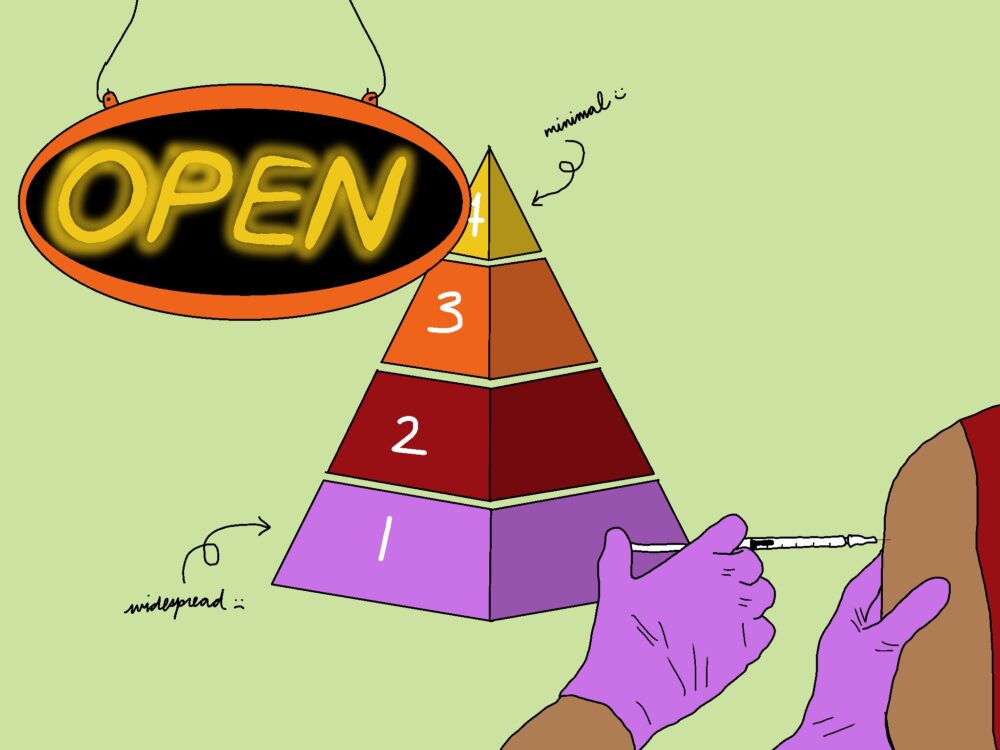
By Tyler Sonderholzer
Governor Gavin Newsom’s “Blueprint for a Safer Economy” plan has four major COVID-19 restriction tiers for all of California’s counties to follow. The tiers, from most to least restrictive, are purple, red, orange and yellow.
The tiers are based on the case rate per 100,000 residents, the positive test rate for the entire county, and the lowest health equity quartile’s positive test rate. The case rate factor also depends on the number of Californians who are vaccinated in some of the hardest-hit Californian communities.
Purple Tiet
The purple tier is the most restrictive tier out of the four tiers in California, and it means there are widespread COVID-19 transmissions in the respective county.
For a county to be in this tier, the daily new case rate has to be above 10% and the test positivity rate has to be above 8%. Currently, eight Californian counties are in the purple tier, where most aspects like dining, gyms and theaters are all restricted to outdoors.
The state’s sports requirements only allow outdoor low-contact sports such as running, golf and cross country. In this tier, schools must remain closed for online learning but schools that were already allowing in-person instruction before a county moved to the purple tier are allowed to stay open.
Red Tier
The red tier is what most of California’s counties are under at the time of publication. The red tier eases some restrictions of the purple tier such as schools can reopen for in-person instruction, inside dining can reopen at 25% capacity and movie theaters can re-open at 25% capacity.
Meanwhile, professional sporting events can reopen at 25% capacity and theme parks can reopen at 15% capacity starting on April 1st. Outdoor moderate-contact sports such as baseball, softball, tennis and cheerleading are allowed to resume. For a county to move into the red tier, there needs to be a 6-10% daily new case rate per 100,000 residents, 5-8% positive tests for the entire county and less than 8.1% positive tests in the health equity quartile.
Orange Tier
The orange tier currently has seventeen counties such as Orange County, which moved to the orange tier on March 31. The requirements for a county to be able to move into the orange tier, there must be 1-3.9% daily new cases, 2%-4.9% positive tests for the entire county and less than 5.3% positive tests for the health equity quartile.
Outdoor high-contact sports such as basketball, football and soccer and indoor low-contact sports such as bowling, curling and gymnastics can resume in the orange tier. Professional sporting events can expand to 33% capacity and theme parks can expand to 25% capacity.
Yellow Tier
Only one county is currently in the yellow tier, which is the least restrictive tier, and the metrics to reach the yellow tier are less than 1% daily new case per 100,000 residents, less than 2.0% positive tests for the entire county and less than 2.2% positive tests for the health equity quartile.
Outdoor professional sporting events and live performances can expand to 67% capacity and theme parks can expand to 35% capacity. Indoor moderate-contact and indoor-high contact sports, such as ice hockey, dance, volleyball and wrestling, can resume.
Overall, the restrictions are based on how well a county is slowing the spread of COVID-19. The better a county does at slowing the spread, the fewer restrictions there are.
It is essential for Californians to work together so we can have fewer restrictions and have some resemblance of pre-COVID-19 life. Follow the state’s requirements and listen to the top health officials. It may not be ideal but it necessary to slowly get rid of COVID-19 and go back to normal life.





